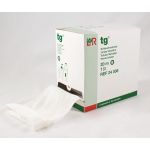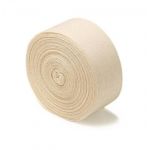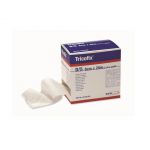Tubular Stockinette
Tubular Stockinettes For Lymphedema
Tubular stockinette is used as an integral part of multi-layered compression bandages.
As the initial layer of multi-layer compression bandage, (which are often used in the treatment and management of lymphedema), a tubular stockinette covered by padding can help protect fragile skin from the pressure caused by compression bandages.
Shop our tubular stockinette with pre-tax savings using your FSA or HSA account!
Tubular Stockinettes For Lymphedema
Tubular stockinette is available in either standard inelastic or elastic varieties, and is made from either 100% cotton or synthetic materials. The elastic tubular stockinette is woven to enable the stockinette to conform to the shape of the limb, and the elasticity of the fabric allows the stockinette to accommodate swelling, without discomfort or constriction.
Our selection of tubular stockinette includes:
- PolySoft tubular stockinette for lymphedema
- Alba tubular stockinette for lymphedema
- TG tubular stockinette for lymphedema
- Tricofix tubular stockinette for lymphedema
- TG Jersey cotton tubular stockinette for lymphedema
- Alba synthetic tubular stockinette for lymphedema
Before applying a tubular stockinette, it’s recommended that you use a suitable skin care lotion to help keep the skin moist and healthy.
••••••••••••••••••••••••••••••••••••FAQs About Tubular Stockinettes
Tubular stockinettes are an important component in the management of lymphedema. Below are some of the most frequently asked questions about tubular stockinettes.
- What Are Tubular Stockinettes
- How Do Tubular Stockinettes Help With Lymphedema
- What Are The Most Common Uses For Tubular Stockinettes
- Are There Different Types Of Tubular Stockinettes
- cotton stockinettes (soft and highly breathable, ideal for sensitive skin)
- synthetic stockinettes (made from synthetic fibers like polyester or nylon, more durable and elastic)
- blended stockinettes (made from cotton and synthetic fibers, offer the benefits of both materials)
- viscose stockinettes (known for their silk-like feel and moisture-absorption, extremely soft and gentle on the skin)
- Are Tubular Stockinettes Available In Different Thicknesses
- How Do I Choose The Right Size Of Tubular Stockinette
- How Tight Should My Tubular Stockinette Be
- What Is The Correct Way To Put On A Tubular Stockinette
- How Often Should My Tubular Stockinette Be Changed
- Can Tubular Stockinettes Be Washed And Reused
- What Is The Difference Between A Tubular Stockinette And A Tubular Bandage
- Do I Need A Prescription To Get Tubular Stockinettes
- Do Insurance Companies Cover Tubular Stockinettes
- Does Medicare Cover Tubular Stockinettes
Tubular stockinettes are seamless, knit tubes made from cotton, polyester, a blend of both, or other materials. These stockinettes are designed to be worn under compression bandages or garments to protect the skin, absorb sweat, and help evenly distribute pressure.
Tubular stockinettes play a key role in lymphedema bandaging by providing a protective layer between the skin and compression bandages, helping to prevent irritation and discomfort. The stockinettes also ensure a more uniform distribution of the compression provided by bandages or garments, which is crucial for effective lymphedema management.
In addition to treating and managing lymphedema, tubular stockinettes are also often used under casts or splints, to help protect the skin.
Tubular stockinettes are available in various types, to meet different needs and preferences. The most common types of tubular stockinettes include:
Tubular stockinettes come in varying thicknesses. Thicker stockinettes provide more cushioning and protection and are often used under compression bandages, while thinner stockinettes are less bulky and are often used under compression garments.
For all of our tubular stockinettes, we have sizing charts from the manufacturer. For most stockinettes, you will take multiple measurements (including the circumference of your limb that is being treated) to ensure the correct fit.
Your tubular stockinette should fit snugly, but not so tightly that it restricts your circulation or causes discomfort.
To put on a tubular stockinette, slide it gently over your arm or leg, and smooth out any wrinkles or folds. The stockinette should cover the entire area of your arm or leg that will be under a compression bandage or garment, without any doubling over or gaps.
In general, you should change your tubular stockinette at least daily, or more often if it becomes wet or soiled (which can lead to skin irritation and/or infection).
Most tubular stockinettes are designed to be washed and reused. If you wash them, use a mild detergent and lukewarm water, then air dry them. Avoid fabric softeners and bleach, as they can degrade the material.
Tubular stockinettes are designed to be used as a protective underlayer beneath compression bandages and garments, while tubular bandages are used to apply compression.
No. You can order all of our tubular stockinettes without a prescription.
Some insurance plans cover tubular stockinettes, with a prescription for compression bandaging. Check with your insurance provider for specifics about your coverage.
Starting in January 2024, thanks to the Lymphedema Treatment Act, Medicare began covering compression products, including compression bandaging systems and supplies that are used during the initial decongestion phases and maintenance phases of lymphedema treatment. Click here to read more about the Lymphedema Treatment Act and how to order tubular stockinettes.
Please note that all of the information above is for general informational purposes. Please consult your healthcare provider for specific information and personalized recommendations for your situation.
For more information about our tubular stockinettes for lymphedema, please call (800) 700-1032, or e-mail info@bandagesplus.com
••••••••••••••••••••••••••••••••••••Medicare Pays For Lymphedema Products
Please note: Thanks to the Lymphedema Treatment Act, which took effect on January 1, 2024, Medicare began to pay for lymphedema products for those who have Medicare B coverage and meet certain other coverage criteria. Please visit our website page covering the details of the Lymphedema Treatment Act to obtain more information about how Medicare pays for lymphedema garments, wraps, and bandages.






